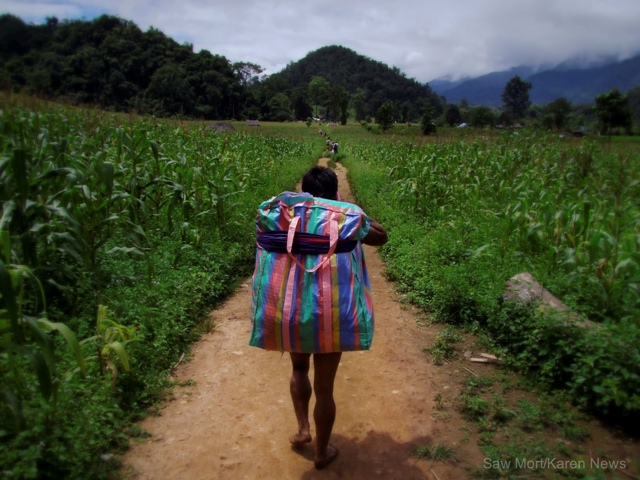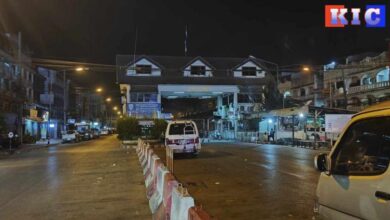No way home – yet?

As the world commemorates refugee week, in Thailand’s largest refugee camp ethnic Karen refugees who fled conflict in Burma struggle with homesickness, discrimination and apprehension of what they’ll find when they return over the border.
Ma Tway considers the uncertainty of her future, takes a long stare into nothing, before answering, “living in a Mae La refugee camp has been a blessing.”
Fleeing an offensive by Burma’s military in Karen State in 1984, Ma Tway says after living in one of Thailand’s refugee camps for 30 years, she’ll never leave. “Even if we were told to resettle, I would not go back. I hope I can continue living with my husband here.”
A constant mantra heard among people among Mae La is that ‘no one chooses to be a refugee’, but for Ma Tway and many ethnic Karen refugees like her, this has been the best option. She is one of around 53,000 refugees living in Mae La refugee camp; the largest of nine refugee camps snaking along the Thai-Burma border, which together house around 150,000 refugees, constituting one of the most protracted displacement situations in the world.
Escaping 62 years of conflict with Burma military – the longest running civil wars in modern history – the vast majority of those living in Mae La are from Karen State, at around 90% of the camp population.
Dependent on the tolerance of the Thai government, and the generosity of NGO’s and private donors, and stuck in a bureaucratic maze for determining legal status in Thailand, the residents of Mae La camp are living in a constant state of vulnerability to exploitation and abuse.
According to a recent report by The Border Consortium, “by the age of five, nearly half of all children were found to be stunted,” due to poor nutrition. “On average rice prices have increased by 80% over the last six years whilst TBC income in Thai baht terms has remained the same,” putting additional stress on funding, the report noted. Although most of the fighting on the border has stopped since the ceasefire, the calm still kills and people are dying daily.
Paw Klu, 62, is a community leader who provides security for refugees at the camp and sees only danger across the border. “It’s very confusing, there are many groups with guns in the area; you have the Burma Border Guard Force (BGF), the Democratic Karen Buddhist Army (DKBA), and the Karen National Liberation Army (KNLA). Things are very tense.”
Paw Klu nevertheless wants to return home after spending 30 years in refugee camps. “If there is real peace in Burma, sure I will go back to my homeland. But the peace is not yet realized.”
On January 22nd local media reported that 20 militia from the BGF, attacked KNLA positions, wounding a soldier and a civilian. Reports of forced labour also continued to surface in January. Incidents such as these, though now increasingly isolated, illustrate how dangerous the situation remains along the border.
Adding to this conflict-ridden context, Eastern Burma is one of the most heavily infested land mine zones in the world. It’s been estimated that 5.2 million people live in areas contaminated by landmines in Myanmar.
In 2011 there were 381 documented casualties from land mines, the majority of those maimed – around 200 – were civilians, according to the International Campaign to Ban Landmines (ICBL).
With many incidents occurring in isolated jungle areas, the ICBL noted that the actual number of casualties could be much higher, citing a figure as high as 600. The ICBL also noted that Burma’s military and armed groups were still using land mines.
Refugee advocates argue that Thailand’s vague refugee policy contributes to an already unstable situation.
In a 143 page report called ‘Ad Hoc and Inadequate: Thailand’s Treatment of Refugees and Asylum Seekers’, Human Rights Watch criticized Thailand’s refugee policies as causing refugees of all nationalities to be “exploited and unnecessarily detained and deported.”
The Thai government has registered only about 60 percent of the 140,000 people in the nine refugee camps along the Thai-Burma border. The TBC says that the remaining 40% are unregistered. The last major phase of registration was in 2005.
HRW argues that this leaves refugees in an impossible position.
“While these camps offer some element of protection, by remaining in the camps without any source of real income, refugees become completely dependent on aid agencies,” HRW said in the report.
Bill Frelick, HRW’s refugee program director, says, “Thailand presents Burmese refugees with the unfair choice of stagnating for years in remote refugee camps or living and working outside the camps without protection from arrest and deportation.”
Thailand has not ratified the 1951 Refugee Convention and does not have a refugee law or functioning asylum procedures. It regards refugees living outside of official camps as being in the country illegally.
Now too old to be a farmer, Ma Tway doesn’t see how she can make a living back in Karen State. “Now, I am too old to get work in Burma. It would be very hard for me to find work and even if you work hard, you are forced to pay taxes to many different armed groups, often leaving you with little or no money for food.”
Ma Tway says, “The price is also very high for food, things like rice are quite expensive, and if you don’t have a job, you don’t have any money for food at all. What will we do?”
“My husband is an invalid, he is deaf and he can’t walk. I have to take care of him all the time; it’s a big responsibility for me. Even if the Thai government and UNHCR told us to resettle, I cannot go back. I hope they’ll let me stay in the camp, so I continue living with my husband here.”
Both Ma Tway and Win Kyi have no idea how they will survive in Burma. Too old or weak to set up new lives inside Karen State, what will be done to support them and ensure that they, and the ones they care for, can survive in their long-lost homeland? And if they are returned in the next few years, what role will they play in the future of Burma?




